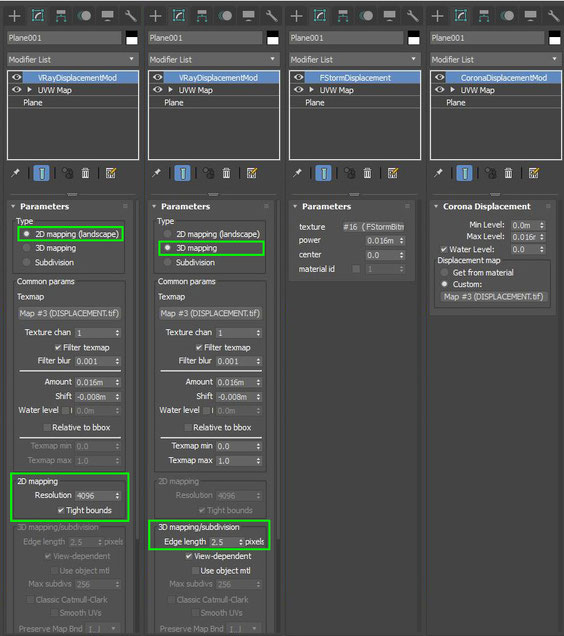Displacement Comparisons between Engines using Scanned Textures
Hello there. This time I want to share with you the results I got after some tests comparing the behavior of 4 render engines in 3ds Max using the Displacement Mod that works only at rendertime (not real displaced geometry).
Scene Setup
The render engines used were: Vray Advance (CPU), Vray RT (GPU Cuda), Fstorm and Corona. I treat Vray Adv and Vray RT GPU as separate engines because it's proved that their core work differently, when you work with them you can get different results even when using the same settings and setups. The best of this is that both of them work very well under different conditions and they are included in the same software licence.
From this point forward I'll refer to Vray Advance (CPU) and Vray RT (GPU Cuda) just as Vray Adv and Vray RT respectively.
The following image shows the geometry I used. It's only a single plane with it's default segments and a plastic sculpture just as a scale reference.
Here are the settings of the Displacement Mods used for the tests. Notice that Vray Adv can use 2 different types of mapping - 2D and 3D - I remarked the main parameters related to improve the quality of the final displacement. The 2D mapping is sightly better to displace single planes like this and also is faster and uses less RAM than 3D mapping but I'll let you decide later which result is the one you like most.
In the case of Corona, the displacement's quality must be set in the Render Setup> Performance tab. For this test I used the value of 1.0 pixels in "Screen size" mode ("World size" mode is recommended for animations with moving cameras). As you can see I used Path Tracing for the Global Illumination because I wanted to get more accuracy. Precalculated solutions as UHDCache in Corona or LightCache in Vray usually lose some small details.
With Vray I also wanted the more accurate G.I. solution so I set Brute Force for both calculations.
Technical Specs
For all the test I've done for this article I tried to use the same settings between the different engines so I could get the best comparisons possible. Here are some universal specifications:
- Image Size: 1800x900 px.
- Render time: Limited to 3 minutes.
- Materials: I initially used Vray and then I ran the FstormConverter and CoronaConverter and did some small adjustments to equal the results of reflections and bump effects.
- All the Day Scenes were rendered with Vray-Fstorm-Corona Sun and Sky respectively.
- All the images were saved without any color corrections or effects.
- All the images have no post-production.
- Textures: All the textures used were Scanned Textures. The format is 16-Bit Tiff at 32K Resolution. You can buy them at friendlyshade.com

The Tests
Important: Please consider that the renderings you're about to see were made to compare ONLY the way that the Displacement Mod works and not to compare the differences of G.I., light intensity or tones that are clearly noticeable. Remember that biased and unbiased engines work different, also consider that Fstorm and VrayRT are GPU based but mainly keep in mind that each engine has it's own way to render. That's the beauty of the diversity!
Here's the first test using day lighting. Please click on the enlarge icon to see the images at full resolution so you can notice the small details between each one.
And here are the tests with nightly lighting.
Conclusions
Here are some comparisons I analyzed from the results obtained:
- Vray Adv showed better performance using 2D mode than 3D mode. The 2D mode displaced smaller details noticeable in the edges of the stones and it was faster.
- Fstorm worked really fast and showed a great result but I couldn't find any option to change the blur value or filtering of input image to make it sharper.
- Corona was tested also with quality of 0.5 pixels but the difference in quality wasn't noticeable so I stayed with the 1.0 value.
In my opinion VRAY RT GPU reached the best result. It's quality and detail are really great. And Corona was the one I liked less.
I would love if you share with us your opinion, these is just my point of view but you are the one who has to decide which one you like most.
Bellow you can comment.
Thanks for reading!
Mario Cameras
Share this article:


























Write a comment
Daniela Bringas (Tuesday, 28 November 2017 21:22)
This topic is very interesting, I usually works in Vray and know I pretty sure that vray is the best option to create realistic and better details using displacement.
Thanks for talk about this topic
Beep (Wednesday, 29 November 2017 12:15)
Can you try Blender Cycles for comparison?
Dulce Arreguin (Wednesday, 29 November 2017 15:18)
Thanks for sharing your tests, they show us information that will be helpful to many friends.
Mario Cameras (Wednesday, 29 November 2017 15:50)
@Beep That sounds good. Actually I did the tests with only the software I use on a daily basis. But if I install Blender someday I will do some tests. For the moment if you go to the FriendlyShade website all the renders you see there were made with Blender>Cycles.